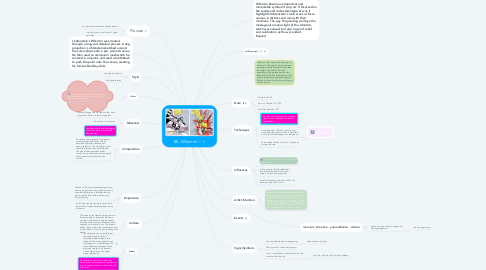8E - Whamm!
da Renee Brown


1. Lichtenstein's Whamm! was created through a long and detailed process. Using projection, Lichtenstein sketched around the comic strips onto a pre- primed canvas. He then used an aluminium mesh which he covered in oil paint, and used a toothbrush to push the paint onto the canvas, creating his famous Ben-Day dots.
2. Process
2.1. he used canvas that were already primed
2.2. it took him one month todo 2 wham paintings
3. Style
3.1. the style of whamm
3.2. Enlarged cartoon
4. Colour
4.1. the main object in each of the images are bright coloured, and the backround is a bland/mid grey colour
5. Materials
5.1. He used Magna Paint for the bits that were coloured in which is a fast drying paint
5.2. Acrylic and oil on canvas
5.3. Scrubbing brush and Homemade Aluminium Mesh to create the Ben-day dots
6. Composition
6.1. Comprises of two equally sized panels, measuring 68 by 80 inches with an American fighter jet destroying an enemy fighter jet. The main focus is the destroyed jet and the word WHAAM, this part of the artwork has bright colours and is oddly shaped, compared to the neutral coloured rest of the artwork.
7. Experience
7.1. We see an American jet winning against an enemy, we get told a story by being able to see what the jet pilot is thinking, then we get to see the result with the enemy jet being blown up
7.2. A lot of the people viewing the artwork at the time had fought/witnessed/been a part of the war
8. Culture
8.1. This artwork was created during post war America where to boost the economy modern media became very prominent including advertisement, celebrity culture, cartoons, movies and more. The artwork whaam looks at both the recent war as well as the influence of comic books through the media
9. Subject
9.1. The subject for his art practice was everyday imagery. He took everyday imagery (objects) and changed it from its original source, displaying it in a different way. The way Lichtenstein portrayed these everyday objects in his artworks often differed from it's original purpose/meaning.
9.2. He sometimes made his art depicting stereotypical representation of gender such as male female roles and turned them into ironic jokes.
10. main jet - America - you/audience - winner
10.1. yellow - pops out from background - warning/explosion
10.1.1. colours of germany
11. Whamm! became an important and memorable symbol of pop art. It focussed on the reality and male stereotype of war. It highlights Lichtenstein's main areas of focus- women in distress and men with their machines. The way the painting portrays the message also makes light of the situation, which was unusual but also a sign of relief and celebration as the war ended. Expand
12. "Whamm!" was apart of the the pop art movement. The pop art movement took everyday, ordinary items and made them the subject of art works. This was appealing to the average person who thought they couldn't understand art. The pop art movement questioned peoples beliefs of what art had to be, making very mixed opinions.
13. Art Movement
14. Date
14.1. Painted in 1963
14.2. born on October 27, 1923
14.3. died 9 September 1997
15. Techniques
15.1. Ben-Day dots: Colour-points that were spaced and overlapped to create an optical effect.
15.2. onomatopoeia: i think he chose to use onomatopoeia because it has a big effect on the sound and language of the pop art
15.2.1. Whamm!
15.3. harsh outline, blocks of colour - inspired by printing process
16. Influences
16.1. i think the key influence was the planes from the war.
16.2. in this artwork i think Lichtenstein’s influences consisted of the war as there is a plane and explosions
16.3. An influence being and issue of DC's all American men of war comic
17. Artist Intention
17.1. roy was inspired to create this artwork from the original comic strip and how the artist could take a complex story and turn it into a simple comic drawing. many people called Roys work an appropriation but his intention was to take an existing image and changing the context to give it a different meaning.
18. Events
19. Signs/Symbols
19.1. text - emphasise what is happening
19.1.1. adds structure to chaos
19.2. War - symbol of masculinity/power
19.3. comic - simplifying a serious subject as the media at the time did
19.3.1. comic is a familiar form for the audience
